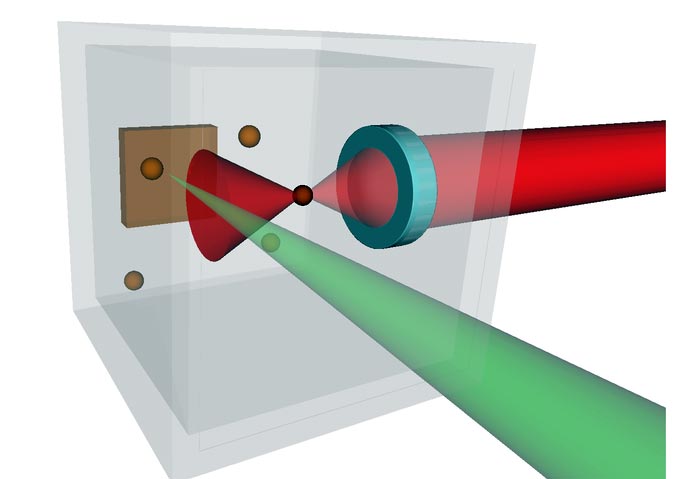Stirring a superfluid with a laser

Schematics of optical trapping in superfluid helium
Credit: Minowa, Yosuke
Researchers at Osaka University use optical tweezers to control nanoparticles within an ultracold phase of matter called superfluid helium, which may lead to a better understanding of the interactions between quantum and macroscopic objects.
Scientists from the Graduate School of Engineering Science at Osaka University used optical tweezers for the first time inside superfluid helium. With a strongly focused beam of light, they demonstrated the stable trapping of nanoparticles at ultralow temperatures. This work may help scientists better understand the conceptual boundary that separates classical and quantum effects.
Studying the strange world of quantum mechanics is often difficult, because some of the most interesting phenomena occur only under extreme conditions. For example, when helium is cooled to very low temperatures, it can form a superfluid state which flows without viscosity or friction. This change is due to the quantum “wavelike” nature of matter, in which the ultracold helium atoms begin to coordinate and behave almost like a single particle. While the existence of superfluid helium has been known for a long time, the way that it interacts with larger objects has not been fully studied.
Now, a team of researchers from Osaka University manipulated nanoparticles suspended in superfluid helium using optical tweezers. They were able to use this optical trapping effect to confine metallic and dielectric nanoparticles in the superfluid helium that was just 1.4 degrees above absolute zero. “This experiment was the first successful application of optical tweezers at ultralow temperatures, because we were working at 271 degrees centigrade below zero,” first author Yosuke Minowa says. The trapped nanoparticles were made of gold or zinc oxide, between 10 and 80 nanometers in size, and could remain suspended for up to 30 minutes.
Optical tweezers allow for the three-dimensional confinement of tiny nanoparticles using a strongly focused beam of light from a laser. The light acts like a “tractor beam,” and this method is widely used in physics, chemistry, biology, and medical research. Normally, optical tweezers operate at room temperature, but this study opens the way for new cryogenic applications. “Our work enables exploring unprecedented interactions between quantum fluids and classical nanomaterials,” Minowa says. In superfluid helium, tiny whirlpools called vortices appear, but each can only spin at certain allowed values. In the future, nanoparticles might be used to visualize or even control these vortices. This research may help better understand the transition between the quantum realm and familiar laws of physics.
The article, “Optical trapping of nanoparticles in superfluid helium” was published in Optica at DOI: https://doi.org/10.1364/OPTICA.447557
About Osaka University
Osaka University was founded in 1931 as one of the seven imperial universities of Japan and is now one of Japan’s leading comprehensive universities with a broad disciplinary spectrum. This strength is coupled with a singular drive for innovation that extends throughout the scientific process, from fundamental research to the creation of applied technology with positive economic impacts. Its commitment to innovation has been recognized in Japan and around the world, being named Japan’s most innovative university in 2015 (Reuters 2015 Top 100) and one of the most innovative institutions in the world in 2017 (Innovative Universities and the Nature Index Innovation 2017). Now, Osaka University is leveraging its role as a Designated National University Corporation selected by the Ministry of Education, Culture, Sports, Science and Technology to contribute to innovation for human welfare, sustainable development of society, and social transformation.
Website: https://resou.osaka-u.ac.jp/en
Journal: Optica
DOI: 10.1364/OPTICA.447557
Article Title: Optical trapping of nanoparticles in superfluid helium
Article Publication Date: 20-Jan-2022
Media Contact
Saori Obayashi
Osaka University
gi-strategy@cgin.osaka-u.ac.jp
Office: 81-661-055-886
Original Source
All latest news from the category: Materials Sciences
Materials management deals with the research, development, manufacturing and processing of raw and industrial materials. Key aspects here are biological and medical issues, which play an increasingly important role in this field.
innovations-report offers in-depth articles related to the development and application of materials and the structure and properties of new materials.
Newest articles

Pinpointing hydrogen isotopes in titanium hydride nanofilms
Although it is the smallest and lightest atom, hydrogen can have a big impact by infiltrating other materials and affecting their properties, such as superconductivity and metal-insulator-transitions. Now, researchers from…

A new way of entangling light and sound
For a wide variety of emerging quantum technologies, such as secure quantum communications and quantum computing, quantum entanglement is a prerequisite. Scientists at the Max-Planck-Institute for the Science of Light…

Telescope for NASA’s Roman Mission complete, delivered to Goddard
NASA’s Nancy Grace Roman Space Telescope is one giant step closer to unlocking the mysteries of the universe. The mission has now received its final major delivery: the Optical Telescope…


